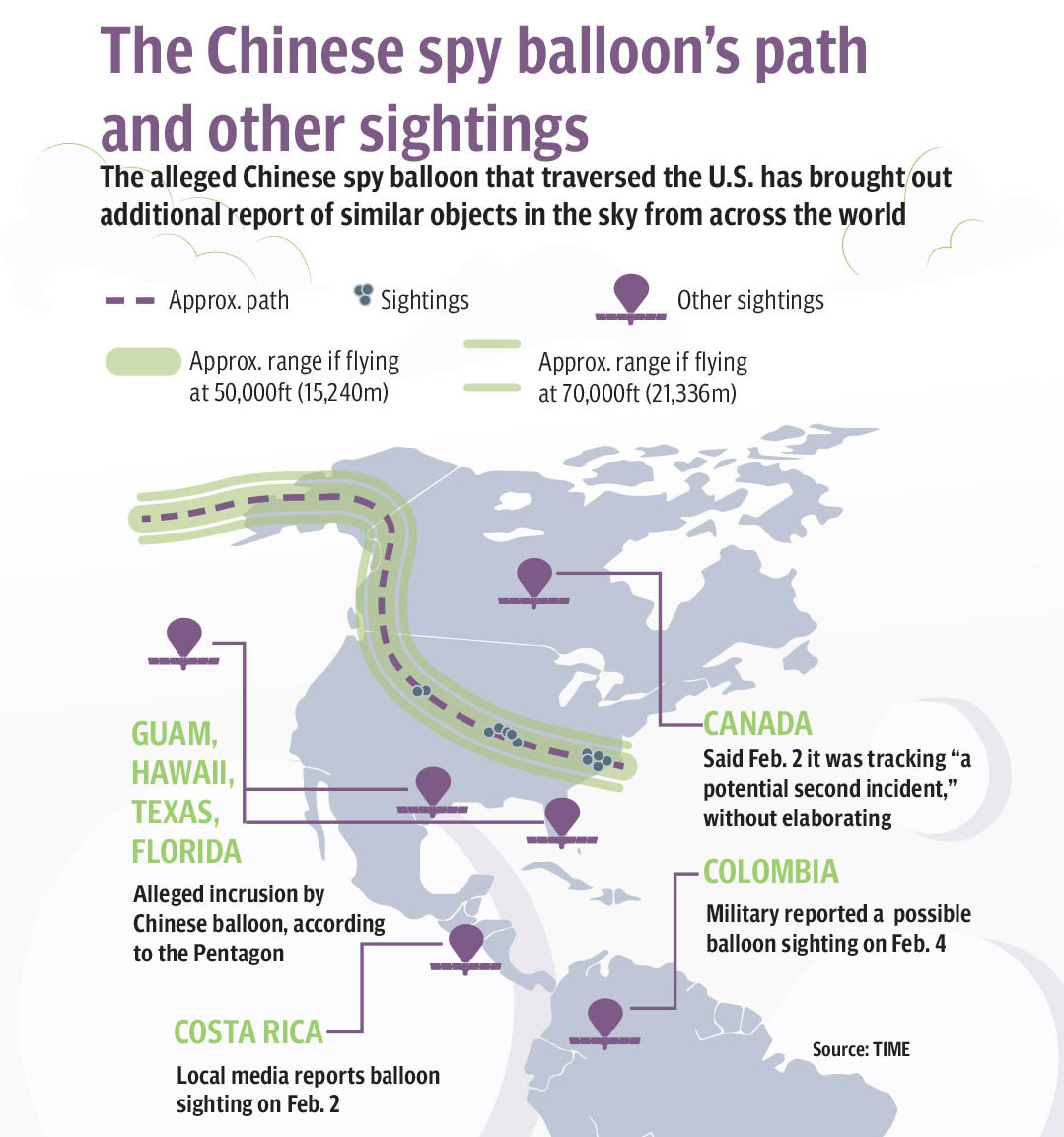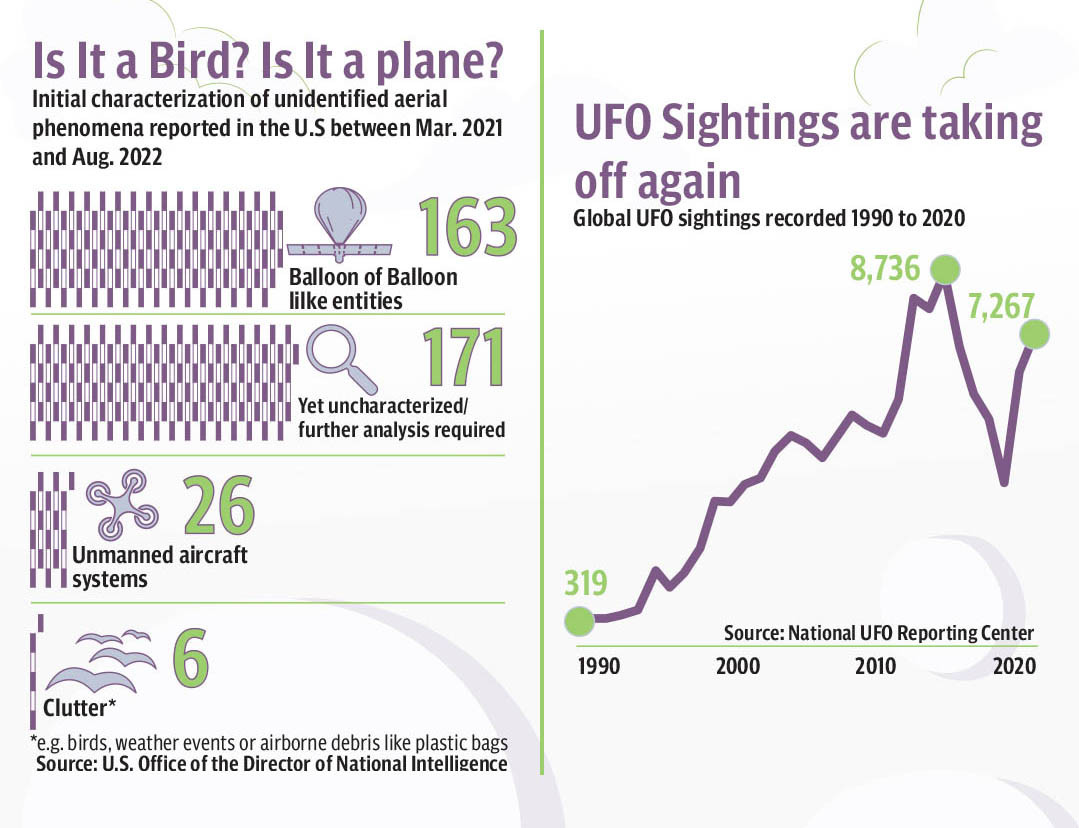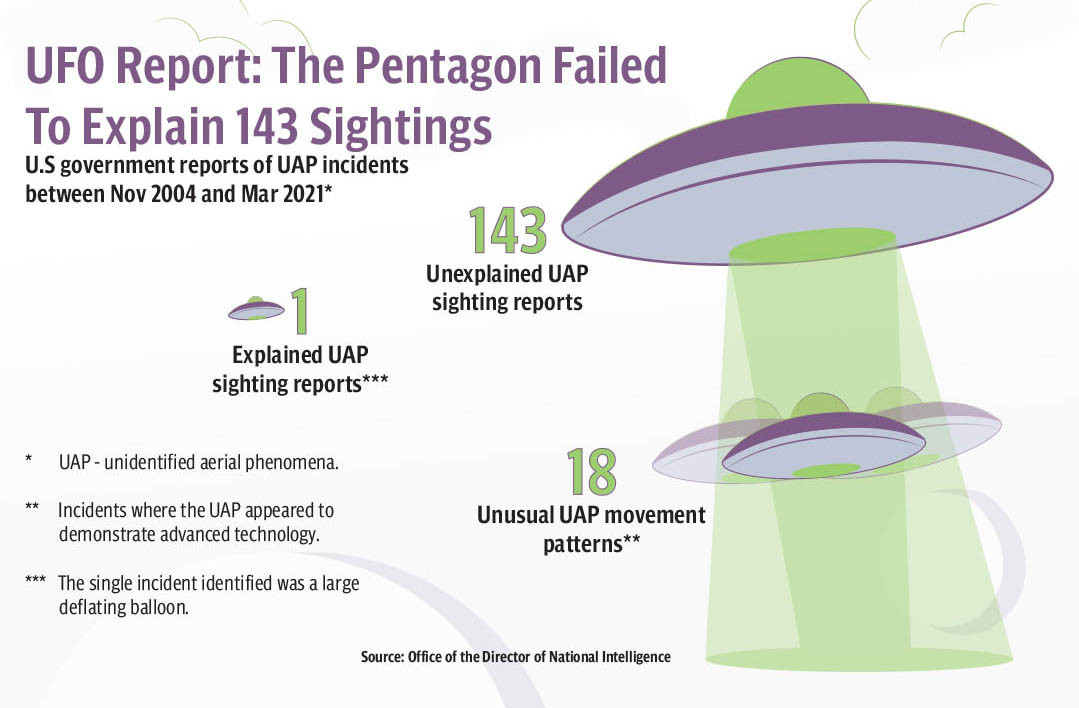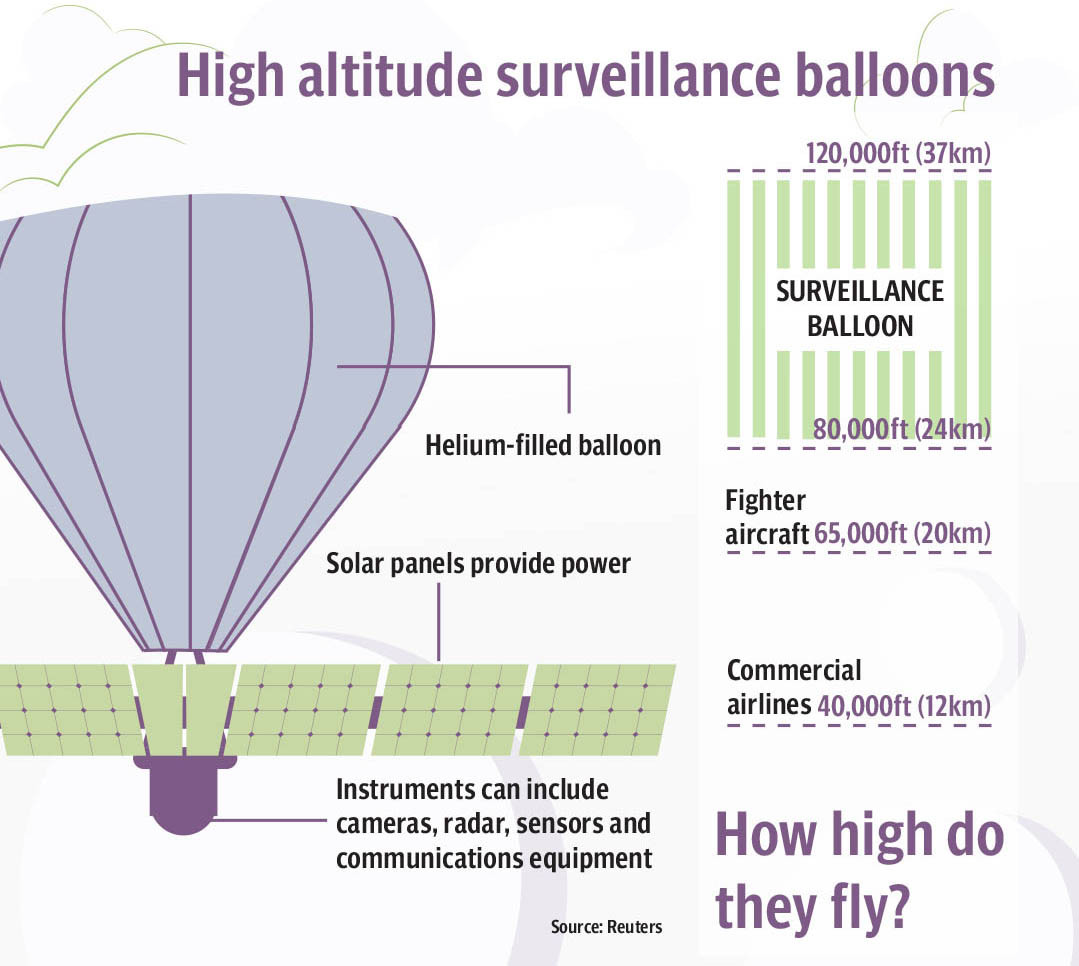Amid tensions over the South China Sea and the war in Ukraine, while they dance delicately in what has been described as a full-blown trade war, the United States and China were at the heart of a rather strange episode earlier this year.
Between the last couple of days of January and the first handful of February, an immense high-altitude balloon drifted languidly over the continental United States, posing a mysterious sight for all those who could see it from the ground. When the US military finally pulled the trigger on shooting it down, Washington accused Beijing of conducting espionage over its sensitive sites. Protesting vehemently its destruction, China maintained the airship was a civilian craft intended for meteorological purposes that had been blown off course.
Stranger still were a string of still mysterious aerial incidents that occurred over North America in the days that followed. Between February 10 and 12, three unidentified high-altitude objects were shot down. Described initially as ‘small, cylindrical’ objects using an ‘undetermined’ form of propulsion, the US government later clarified that the targets in question were likely private entities with no relations to China.
But as soon as an aerial phenomenon or flying object is deemed ‘unidentified’, the conspiracy theory mill runs wild. From a technology straight from the pages of science fiction developed in utmost secrecy to of course, aliens – all sorts of strange explanations found their way to the public imagination.
But prominent experts specialising in defence, aviation and espionage, explain that the likeliest of explanations, despite our flights of fancy, remain the simplest ones.

Design: Ibrahim Yahya
Follow the balloon
Before diving deep into unexplained aerial phenomenon – which have their own new acronym in UAP that seeks to dethrone the UFO of old – the experts The Express Tribune reached out to suggested it was best to start with the one that gathered the most attention.
“The one that we know the most about is the very large balloon that flew over the United States from Hainan, which is an island off the south of China,” shared Dr Andrew Hammond, a historian and curator at the International Spy Museum in Washington DC. The balloon, he explained, came over the Aleutian Islands off the coast of Alaska and then drifted over Canada and the American states of Montana, Wyoming and Missouri before was shot down by an US Air Force F-22 fighter off the coast of South Carolina. Over the course of its journey, the balloon travelled over some important strategic parts of America’s defence system, he pointed out.
“What we know is that it was almost certainly not a weather balloon, which are typically much smaller,” Dr Hammond said. “Weather balloons don’t travel for thousands of miles… they generally don’t cross the Pacific and the continental United States.”
Agreeing with Dr Hammond’s assessment, Dr James Rogers, a war historian who works with prominent media outlets like the BBC, History Channel and Netflix, said that the balloon that travelled across the US was hundreds of meters wide in circumference. “These balloons have the ability to loiter and to be controlled remotely… [and] they can fly somewhere around 70,000 to 80,000 feet, perhaps even 100,000 feet,” he said, describing the balloon in question and a second one detected over Latin America.
According to Dr Rogers, these balloons are controlled by adjusting their altitude to allow them to move into a different wind pattern. “Now that hasn’t gone to plan in China’s case. We don’t know if they lost control like they said they did or if that was the plan all along,” he shared.
“If it doesn’t look like a weather balloon and it doesn’t move like a weather balloon, we have to assume it’s a balloon for intelligence purposes,” added Dr Hammond. “Whether or not this was their intended course or whether it was redirected is another matter.”
In the media and among security experts, discussion has focused on the sensitive intelligence-gathering capabilities of the payload the balloon carried, which has been described as being the size of a small car. “The latest camera surveillance technology, like the Gorgon Stare in the US, has the ability to survey a whole city at once. We’re talking thousands of individual targets they can zoom in on and inspect in almost real time. We know that China is at least at parity with this sort of surveillance technology,” shared Dr Rogers.
The intelligence purposes the balloon could be for, Dr Hammond speculated, would be broader than just imaging. “That would be one part of the sensor package but I think the other parts would be signals intelligence and communications monitoring, and measurements or signatures intelligence, which looks at things like gases or vapours to ascertain whether certain kinds of experiments are taking place.”
Dr Rogers noted that these sort of suspicions are why the Biden administration decided to shoot this balloon down. “There were worries that it could surveil sensitive military and nuclear sites… We don’t know if it could intercept messages and data, but there is a lot of worry within the US that it could.”

Design: Ibrahim Yahya
Explaining the hysteria
Speaking about the intense media coverage and public attention the initial balloon incident received, Dr Hammond said that the world of espionage is normally hidden from the masses. “It’s something that takes place in secrecy, whether its satellites in outer space, spies in back streets, communications intelligence or armies assessing other armies,” he said. “You never see those things in front of you, unlike this spy balloon that many people in the US could see in the sky from their backyard.”
“That is why I think it struck a chord with a lot of people, especially here in the United States and that is one of the reasons why I think this is so significant,” he added.
That said, Dr Hammond did draw attention to the wider strategic picture between the US and China, particularly tensions in the South China Sea.
Analog tech in a digital world?
Asked about the perception of balloons as rather ‘quaint’ in the eyes of common people, Dr Hammond said: “I wouldn’t use that word but balloons may appear to people as a very analog technology in a very digital age.” He noted that it was important to highlight that the balloon that flew over the US and modern balloons in general were very different from a technology that first saw military use in the French Revolutionary Wars.
“What’s that same is that it is some kind of inflated material that uses some kind of gas to take it up into the sky,” Dr Hammond said. “But the balloon we saw some weeks back was incredibly sophisticated. It was powered by 16 solar arrays and had a sensor package weighing 2,000 pounds.”
The sensor package, the historian speculated, probably utilised sophisticated algorithms and even artificial intelligence. “So it relies on a basic principle but it has all this modern technology fused to it.”
According to Dr Hammond, espionage in the 20th century has come to be associated with tools like satellites and jet aircraft. “But there are still situations where balloons make more sense,” he pointed out. “Satellites cannot provide surveillance over a particular spot 24/7. Helicopters can hover over a spot for a short period of time but airplanes have to keep moving to remain in the air. A balloon, like this one, could just slowly drift and be there for a greater period of time.”
Another advantage that balloons could provide is in terms of plausible deniability. Dr Hammond pointed to China’s claims that of the balloon being intended for meteorological purposes. “If it was a Chinese military aircraft with a Chinese pilot, then plausible deniability would be very difficult to maintain.”

Design: Ibrahim Yahya
A busy airspace
Coming on to the subsequent high-altitude objects that were detected and shot down over North America, Arthur Holland Michel, a senior fellow at the Carnegie Council for Ethics in International Affairs in New York, said one of the key takeaways from these incidents is that the airspace is much more crowded than we previously would have liked to believe. “It’s now come to be known among the public that there are thousands of different balloons of different types serving different purposes in the airspace at once.”
He said that while there hasn’t been a full disclosure from the US or Canadian authorities about the exact characteristics or purpose of the objects that were shot down after the Chinese balloon, at least one of them was likely to be a balloon that had been launched by just some hobbyists. He pointed to an article by Aviation Week that suggested a balloon declared missing by an Illinois-based hobbyist club on February 15 could be one of three mystery objects.
“It’s a very valuable article because it kind of reveals the whole world of recreational balloon flying communities, which have nothing to do with espionage or national security. But they’re putting things in the sky all the time.”
According to Dr Rogers, it’s not a coincidence these incidents have emerged over the Arctic. “It’s not that aliens particularly love Alaska. It’s that the Arctic is a crucible for the world’s weather patterns and if you want to study them and climate change, you send your weather balloons over there.”
Dr Rogers shared that balloons over the Arctic are not particularly well policed and are launched by everyone from academic research groups, local hobbyists and meteorological agencies. “We don’t have a database and we don’t keep a track of where they are and where they’re going because they present a minimal threat. Quite a boring explanation to an awful lot of fuss.”
Explaining the initial statement from US officials that mentioned an undetermined propulsion source, he said these weather balloons literally just float. “They don’t have a propulsion source because they’re not intended to have one.”
“These things of course will look very different,” Dr Rogers added. “They’re usually a kind of silvery-white giant bag of gas moving around with the wind. They can look quite odd if the sun is shining on it and this is exemplified by the fact that every single pilot that appears to have engaged one of these has handed a very different account of what they’ve seen.”
According to the historian, a fighter pilot sent to intercept such a target has to move and react super quickly. “It doesn’t help that the jet can’t prolong its loitering over a target. It’s going to lead to some level of distortion,” he said. “You’re seeing a UFO incident under construction. You’re seeing how a conspiracy theory is being made in real time.”
Tweaking the sensitivity
One explanation that has been proposed for the subsequent high-altitude incidents is that they were the result of the US increasing its screening of North American airspace following the Chinese balloon incident.
Dr Mauro Gilli, a senior researcher at Center for Security Studies, ETH Zürich, agreed with that suggestion. “My understanding is that there was the balloon we all know about, and after that, the US air defense network changed filtering functions in its radars to see whether there were other balloons up in the sky that had got undetected,” he shared.
“Radars systems emit and capture electro-magnetic returns reflected by objects. To avoid that the radar operator is overwhelmed by returns of little significance, radar systems use multiple filtering functions that automatically exclude such unimportant returns (e.g., excluding radar returns produced by stationary or very slow moving objects),” he explained. “Once the US radar filtering functions were changed, radar systems encountered many more ‘false alarms’ – that is, radar returns that would be automatically ignored by radar systems, would lighten up, and radar operators would mark them as potential targets, which led to the temporary closure of air spaces and similar. My feeling is that this is what happened - and some statements give credence to this interpretation.”
Dr Andrew Hammond of the International Spy Museum put forward a down-to-earth example. “Let’s say your home is broken in by an intruder. You would start to think about ways to increase your security and prevent such a thing from happening again. I think it’s the same case for a government. If something happens, you look at ways to improve your response.”
“We are constantly learning the best ways to detect and react to new experimental air systems. That amount of experimentation is going to lead to bit of confusion,” added Dr James Rogers. He explained that the northern part of US airspace is already the most surveiled airspace of the world because of the idea that if there were ever a nuclear attack from Russia, it would come over the top of the Arctic.
“So if there’s a particularly new system [turned towards the northern airspace], it could probably be one of the reasons why we started picking up all of those weather balloons all at once.”

Design: Ibrahim Yahya
An element of mystery
That said, according to Michel there is still some element of mystery to the incidents reported in the days after the Chinese balloon shoot down. “The information that has been released by the governments of (US and Canada) does not add up to a complete picture,” he said. “A couple of them were quite strangely shaped, which is a little bit unusual. They weren’t flying over the sea… they were flying over continental North America.”
“Without more government disclosure, it’s a little hard to even sort of speculate,” he added.
But before UFOlogists scream ‘aliens!’, Michel said this is a good opportunity to apply Occam’s Razor – the idea that the simplest explanation for something is the likeliest one.
“There are many simpler and kind of boring explanations before we start talking about perhaps the two most headline-grabbing possible explanations – one being that these are foreign powers that have some unknown technology and two, that these are extra terrestrials,” he said.
He pointed out that all sorts of weird anomalous things happen in the sky. “It does have to deal with the fact that in some cases our cognitive system – our eyes and our brain – are not able to make full sense of things that are actually occurring in airspace.”
“We’re seeing them from unfamiliar angles, so there are cases where an object that seems to be defying the laws of physics could actually just be a commercial airliner being observed from a very far distance,” Michel said, adding, that “the difficult thing about that is that its not necessarily easy to figure out that that was what was going on because we’re talking about anomalies in perception. It’s hard to go back and recreate those exact conditions.”
Talking about the suggestion that a likely explanation for these unidentified objects is that they may be some kind of military technology being used by some foreign power, Michel said one should not be that quick to rule this out as a possibility. “The evidence there is simply historical. Countries have in the past developed technologies that previously didn’t exist and used them in a way against their adversaries that created a strategic surprise.”
He pointed to stealth technology as the clearest example of this. “The US developed stealth technology in pretty astonishing secrecy. If you had asked Russia or China in 1968 whether its possible for a plane to be unobservable to radar, that might sound like science fiction even though the US was already at work on it.”
The researcher added that it isn’t out of the realm of possibility that another major power has developed a technology that only sounds like science fiction because they’re the first one to do it.
“In the West and the US in particular, people are unaccustomed to the notion of foreign objects flying over their heads. In other parts of the world, that is not an unusual occurrence,” he noted. “This does make me think about the extensive use of military aircraft including drones in places like Pakistan, Afghanistan and Yemen, and the emotional and psychological effects these aircraft had. That is potentially part of the explanation as to why it is coming as a shock (to people in the US).”
According to Dr Gilli, just the idea that China could penetrate US airspace with a rather unsophisticated technology joined many different narratives in the US media, like the US is falling behind or China is outsmarting the US, etc.
‘I want to believe’
When all is said and done, what keeps people returning to the idea of extra terrestrial visitors whenever unidentified aerial phenomenon are mentioned?
“It just plays in to our human fascination, no matter what country we’re in, that question of whether or not we are alone in the universe,” answered Dr Rogers when asked this question. “If you listen to the smartest astronomers, mathematicians and scientists, it’s becoming increasingly apparent that we’re probably not alone and that one day we may well be visited by another life form.”
“It may seem a bit strange to say, but statistically its more probable than not. All of us are just waiting for that day to happen,” he said.
According to Dr Hammond of the International Spy Museum, the tendency also ties in with the sceptical and inquisitive spirit among human beings. Especially after the Age of Enlightenment and the Scientific Revolution, people are less satisfied with traditional and religious explanations to the question of where we come from, he said.
Arthur Holland Michel, meanwhile, saw the fascination rooted deeply in humans’ historical relationship with the sky. “When I started studying drones, one of the first questions I wanted to figure out was why are people so fascinated and terrified by this technology. Pretty much the first thing that I did was go back to the classics, to ancient Greek literature. I looked at accounts of for example, harpies, and the kind of terror these creatures inspired,” he shared.
“It felt to me like exactly the same phenomenon. Even back in 500 BC, thousands of years before the invention of inhabited flight, people already understood that the air was frightening,” Michel said. “Partly, I think it is tapping into a Western cultural history of UFOs and the weird obsession with aliens, but I think it is also something that goes way further back and is probably universal. A lot of what we’re seeing today taps into a very primal human instinct, which is to flee from things that attack us from the sky.”
“There is nothing new about humans seeing things in the sky that they can’t explain. There has always been weird anomalous stuff happening in the sky that doesn’t square with our understanding of how the world works and what exists in the world,” he added.
According to Michel, the Chinese balloon and subsequent incidents have also shattered people’s sense that the US government knew about all the aircraft in its airspace in a given time. “Now we’ve had this rude awakening that no country has a full awareness of every object in its airspace at all times.”
While calling for transparency, he admitted that there are reasons for governments to keep certain information from the public. “When you talk about government secrecy about things in the sky, people’s mind always goes to Area 51 and aliens. But often these secrets are a lot less interesting than we think they are. They’re only interesting to people with advanced expertise.”
“It may go completely over a person’s head, forgive the pun, if the government says that there is a gap in its radar coverage between 75,000 feet and 78,000 feet. But to China, that is incredibly interesting information,” Michel concluded.
